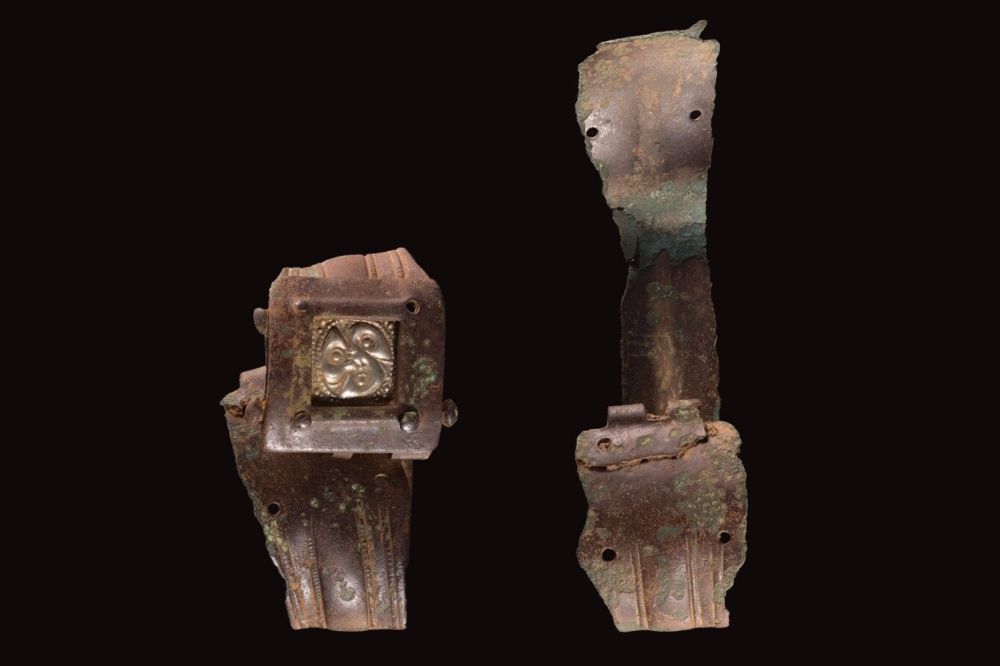Roman treasure found on Ynys Môn

A pair of Roman bracelets which were found on Ynys Môn by a metal detectorist have been declared treasure.
Two copper alloy bands (Treasure Case 23.68) were found by Mr Andrew Hutchinson whilst metal detecting in Llanddyfnan Community, Ynys Môn (Anglesey), in September 2023.
They have since been declared treasure by H.M. Acting Coroner for North Wales (East & Central), Kate Robertson.
Treasure find
As a treasure find, the bracelets were handed in to Sean Derby with Dyfed Archaeological Trust, before being taken in for identification and interpretation by expert curators from Amgueddfa Cymru – Museum Wales at National Museum Cardiff.
Both bracelets are formed of a copper alloy strip decorated with a broad central band and parallel grooves to either side.
Parts of a hinge mechanism survive on each: the ends are rolled into tubes and cut, perhaps to allow interlocking tabs. On one of the bracelets, a square silver plate still survives.
The silver plate has a raised triskele decoration, with the border around it filled with shallower dots.
These bracelets are similar in form and decoration to Roman strap bracelets found in Conwy, Powys, and Plunton Castle in Dumfries and Galloway.
Comparison with associated finds suggests that the bracelets probably date to the 2nd century AD.
Triskele
The triskele symbol is generally identified with Iron Age Celtic designs, though it occurs in artefacts from the Neolithic and Bronze Ages, as well as Greek antiquity.
Its use in Roman artefacts from the 2nd century provides fascinating insight into how culture contact exhibited itself during the Roman occupation of Britain.
The finder, Andrew Hutchinson, said: “This is a lovely find, and I hope it sheds some more light on the history of Anglesey.”
Evan Chapman, Senior Curator of Archaeology, Amgueddfa Cymru – Museum Wales, said: “These bracelets are an interesting example of the mixing of native and Roman design and cultural traditions in a single object.”
Excitement
Ian Jones, the Building and Collections Manager at Oriel Ynys Mon Museum, said: “We are excited by the news of this latest archaeological discovery from Ynys Môn.
“Until the discovery of the Tai Cochion Roman settlement near Brynsiecyn, Roman material has been lacking in our museum collection. These two bracelets would be an excellent addition, and we are pleased to work with Amgueddfa Cymru, the local landowner and the metal detectorist.
“We can’t wait to receive them and to put them on display.
“They will certainly be of interest to our visitors and can be shown to school and educational groups.”
Oriel Ynys Mon Museum & Art Gallery has expressed an interest in acquiring this find for its collection after it has been independently valued by via the Treasure Valuation Committee.
Support our Nation today
For the price of a cup of coffee a month you can help us create an independent, not-for-profit, national news service for the people of Wales, by the people of Wales.







Will Wales be “allowed” to keep them or will the crown and our neighbours demand it belongs to them and they must go to the British Museum?
God forbid the find be declared as ancient British. What’s Roman about them? This mainstream narrative of everything of worth being foreign is wearing thin.
Maybe, just maybe, they are telling the truth and maybe WE are Roman? Would explain a lot, like the mosaics with “Celtic” knots found in Italy. I think the “Roman” was created as a copy of the Britons in order to denigrate us. They? The DM Family, I can’t say their name for obvious reasons. Would also explain why an insular Brythonic people had the third oldest literary language behind only Latin and Greek. Third oldest because We had two languages, Old Brythonic, which was the language of the Poor classes and Latin was the language of the Elite and… Read more »
On a secondary note, would also explain why all the British King lists match up with the supposed birth, Rulership, and death dates with all the Roman emperors! That’s seriously strange.
Yes I’m familiar with this . Britain’s Hidden History u tube channel may be of interest to you.Also try the Matter of Britain, an affiliated channel. I genuinely believe that our history has been deliberately air brushed over the last few centuries.
I am aware buddy, The men behind the research are modern British heroes, who may be looked down on now, but in time will be seen as the great men they are/were.
If the British museum puts dibs on those Roman bracelets it’s goodnight Vienna. I can recall a petition a few years back to bring home the 4000+ year old Gold Cape of Mould and the 34,000 year old Red Lady of Paviland. Both are held in the British museum with the excuse because Wales at the time had no national museum. We do now and still they refuse to give us back what’s rightfully ours! If the Benin bronzes looted by England can be returned home , so must our native artifacts must be too. And unless those treasures found… Read more »
Now that the future of the National Museum of Wales is under threat of closure it is very likely that all of our treasures will end up in English hands. They have taken everything else of value from here. We’ll be potless. The sad thing is that we just let them do it without a fight. Don’t expect support from Vaughan Gethin as has been reported today.
Always Roman, Never British! It’s almost like WE ARE THE ROMANS! Could that explain the “Celtic” Knot artwork on the mosaics found in Italy?